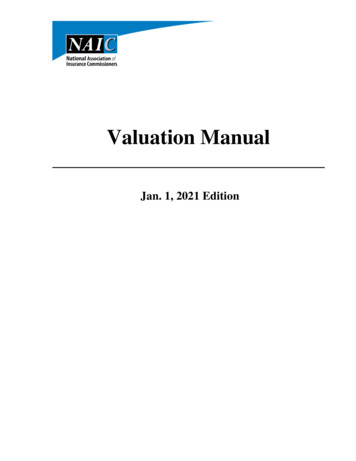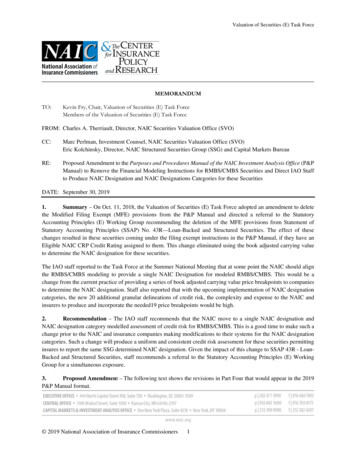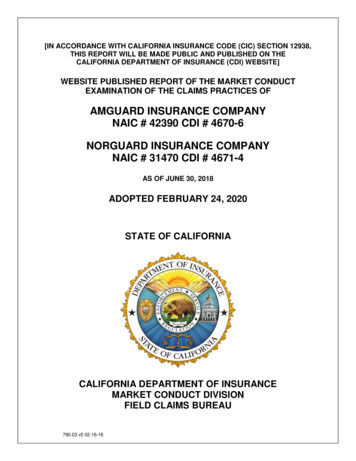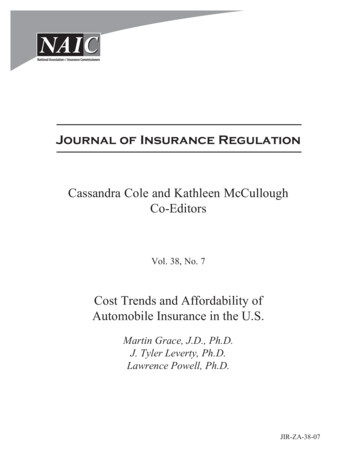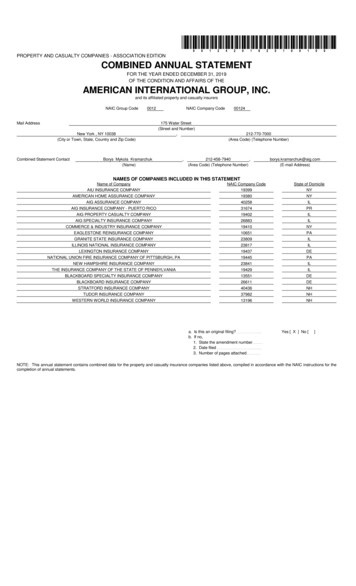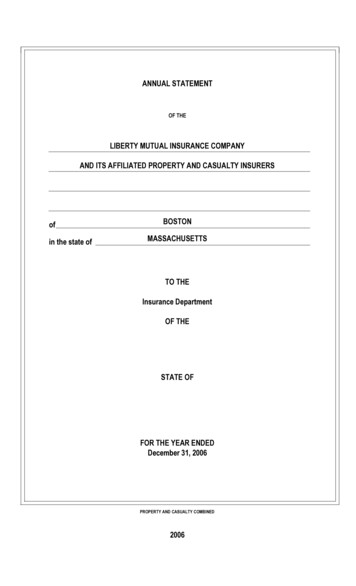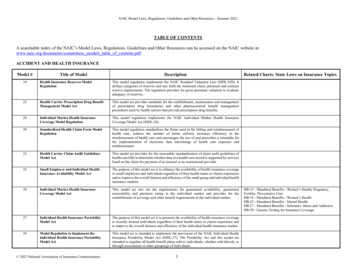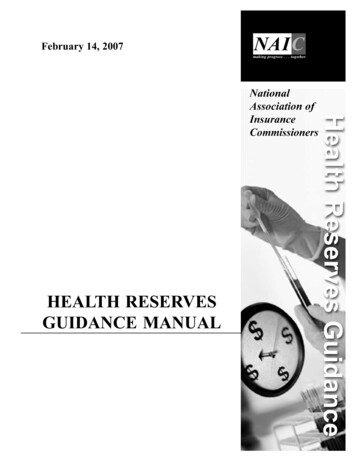
Transcription
February 14, 2007HEALTH RESERVESGUIDANCE MANUAL
Health ReservesGuidance ManualFebruary 14, 2007NATIONAL ASSOCIATIONOF INSURANCE COMMISSIONERS
2001, 2007 National Association of Insurance CommissionersAll rights reserved.ISBN 978-1-59917-130-2National Association of Insurance CommissionersInsurance Products & Services Division816-783-8300Fax 816-460-7593http://www.naic.org/store home.htmprodserv@naic.orgPrinted in the United States of AmericaNo part of this book may be reproduced, stored in a retrieval system, or transmitted in any form or by any means, electronicor mechanical, including photocopying, recording, or any storage or retrieval system, without written permission fromthe NAIC.Executive Headquarters2301 McGee Street, Suite 800Kansas City, MO 64108-2662816-842-3600Securities Valuation Office48 Wall Street, 6th FloorNew York, NY 10005-2906212-398-9000Government RelationsHall of States Bldg.444 North Capitol NW, Suite 701Washington, DC 20001-1509202-471-3990
Table of ContentsPageSection I. Introduction .1Section II. General Considerations .4Section III. Claim Reserves .10Section IV. Contract Reserves .22Section V. Provider Liabilities.25Section VI. Premium Deficiency Reserves.29Appendix (Bibliography of Reference Sources).38 2001, 2007 National Association of Insurance Commissioners
2001, 2007 National Association of Insurance Commissioners
SECTION I. INTRODUCTIONThe purpose of the Health Reserves Guidance Manual is to provide guidance regarding thecalculation and documentation of health reserves for statutory financial statements as describedin the Health Insurance Reserves Model Regulation. This guidance is intended for: Actuaries and other parties who estimate reserves for health coverages;and Examiners who review the statutory financial statements on behalf ofregulatory agencies.The principles stated in this guidance manual do not necessarily apply to financial statementsprepared according to Generally Accepted Accounting Principles (GAAP) or to reserve estimatesprepared for purposes other than statutory financial statements, such as rate filings.These guidelines are intended to be a general statement of reserving principles and not specific,detailed instructions. The guidance manual is designed to encompass all health coveragesincluding medical, dental, disability and long-term care.The manual outlines the minimum guidance for reserving for health coverages and additionalreserves may be appropriate based on actuarial principles and standards of practice. In addition,the standards in this guidance manual may be superseded by applicable state law or regulation.The National Association of Insurance Commissioners’ (NAIC’s) model laws, modelregulations, and this guidance manual do not carry any jurisdiction.The Health Reserves Guidance Manual addresses the following: Claim reserves; Contract reserves; Provider liabilities; and Premium deficiency reserves.This guidance manual does not cover all reserves that may need to be established, and futureversions will address additional categories of reserves.A.Reference SourcesIn preparing the manual, a number of existing standards on reserving for health risks werereviewed, including: Statements of Statutory Accounting Principles (SSAPs);Actuarial Standards of Practice (ASOPs);The NAIC Health Insurance Reserves Model Regulation;The NAIC Financial Condition Examiners Handbook;The American Academy of Actuaries (AAA) Health Practice Notes; and 2001, 2007 National Association of Insurance Commissioners1
Accounting standards and statements of principles from the American Institute ofCertified Public Accountants (AICPA) and the Financial Accounting StandardsBoard (FASB).A bibliography of reference source materials is contained in the appendix to this guidancemanual.ASOPs are promulgated by the Actuarial Standards Board (ASB). Precept 4 of the Code ofConduct of the AAA provides that it is the professional responsibility of the actuary to observeapplicable standards of practice in the jurisdiction in which the actuary renders professionalservices, and to keep current regarding changes in the standards.Practice notes are developed by the AAA to provide information to actuaries on current actuarialpractices in areas that are intended to supplement the available actuarial literature, especiallywhere the areas of practice addressed are subject to emerging technology or recently adoptedexternal requirements. The AAA is the public policy organization for actuaries practicing in allspecialties within the United States. The AAA also develops and upholds actuarial standards ofconduct, qualification and practice, and the Code of Professional Conduct for all actuariespracticing in the United States. Practice notes are not interpretations of standards, nor do theyconvey generally accepted actuarial practices in the same sense that standards of practice do.Actuaries are not in any way bound to follow practice notes.Additional standards on reserving and establishing liabilities for health coverages are found inmodel laws and regulations promulgated by the NAIC. The NAIC is an association representingthe state and U.S. territorial insurance regulatory agencies. The model insurance laws andregulations may be adopted in whole or in part by states. The NAIC also publishes audit guidesand other advisory materials. The audit guide provides instructions and suggestions for carryingout various phases of examinations of insurance companies by state regulatory authorities.Finally, various accounting procedures and standards issued by the FASB and the AICPA werereviewed. FASB is a private organization designated by the Securities and ExchangeCommission to help establish accounting and reporting standards for publicly held companies.The AICPA is the national, professional organization for certified public accountants practicingin the United States. It establishes professional standards and publishes accounting and auditguidance materials.The above sources are referenced later in the manual. Each cited source should be reviewed asthere may be inconsistencies among them.B.Financial Reporting Requirements1.NAIC Annual StatementsThe NAIC Annual Statement Blanks include a number of requirements for the reportingof reserve amounts by companies. These forms include annual statements for life and 2001, 2007 National Association of Insurance Commissioners2
health insurers, health maintenance organizations, fraternal insurers, and property andcasualty insurers.2.Actuarial Opinion and MemorandumHistorically, actuaries have been required to opine that annual statement reserves andrelated actuarial values meet the requirements of the state of domicile. This is still true forcarriers, such as property and casualty carriers, that are not subject to the requirementsdescribed in Model 822, Actuarial Opinion and Memorandum Regulation (AOMR).However, in 1994, the AOMR was revised, and Sections 7B(6)(c) and 8B(6)(c) statedthat the actuarial opinion should include the following statement by the actuary:“In my opinion the reserves and related actuarial values meet therequirements of the Insurance Law and regulation of the state of [state ofdomicile] and are at least as great as the minimum aggregate amountsrequired by the state in which this statement is filed.”In 2001, the AOMR was revised again, and Section 6B(6)(c) stated that the actuarialopinion should include the statement above by the actuary. Section 6F providesalternative wording, which allows the actuary to avoid certifying that, “ are at leastas great as the minimum aggregate amounts required by the state in which thisstatement is filed.”When opining on reserves, the actuary should refer to appropriate and current AOMRrequirements.Also, Section 3 of the AOMR (which is titled “Scope”) states that the AOMR isapplicable to life insurance companies and fraternal benefit societies. Some states maynot extend the AOMR requirements to health maintenance organizations or hospital,medical, and dental service or indemnity carriers; however, the Annual StatementInstructions for these carriers provides for another, essentially similar, actuarial opinion.C.DefinitionsA document titled “Glossary of Actuarial Terms” was developed by the Editorial AdvisoryCommittee of the ASB for use in the ASOPs and the Actuarial Compliance Guidelines of theAAA. That glossary may be referenced for definitions of many key terms used in this guidancemanual. 2001, 2007 National Association of Insurance Commissioners3
SECTION II. GENERAL CONSIDERATIONSThis section addresses issues that are shared by all types of reserves and includes the following:A.B.C.D.E.F.G.A.Multiple Years of DataReconciliationData Quality and DocumentationFollow-up StudiesReserve MethodConservatismRelationship to Risk-Based Capital RequirementsMultiple Years of DataMultiple years of data are required to reasonably estimate the impact of seasonal effects.Changes in the levels of benefits and/or plan provisions, as well as trend, can mask the impact ofthese effects. Therefore, seasonal effects are usually considered only for lines of business thathave been in force for several years and where the structure of benefits has not changedsignificantly.B.ReconciliationAll claim data used to calculate reserves should be reconciled, to the extent possible, with paidclaims reported by the carrier in its financial statement.It should be noted here that the definition of “payment” reflected in the data should be the sameas, or reconcilable to, the definition of “payment” incorporated in the financial statements. Forexample, in statutory financial statements, claims are usually represented as “paid” when a checkor draft has been issued, rather than when it has been cashed; uncashed checks or drafts arereported as an offset to cash. If the reserving data represent claims as paid when a check isissued, then the claim reserve will be consistent with the paid claims in the financial system.However, if the reserving data represent claims as paid when they are adjudicated, it typicallywill be necessary to establish an additional claim reserve component representing adjudicatedclaims for which checks have not yet been issued.C.Data Quality and DocumentationIt is the actuary’s responsibility to review data for consistency and reasonableness. This issue isaddressed by ASOP No. 23, “Data Quality.” 2001, 2007 National Association of Insurance Commissioners4
The following describes some of the standards in ASOP No. 23 that are pertinent to the qualityand documentation of data used to establish reserves for health products:1.The actuary should consider what data to use, based on the scope of the assignment andthe intended use of the analysis [Section 3.2].2.The actuary may rely on data supplied by others and should disclose such reliance[Section 3.3].3.The actuary should, when practical, review the data for reasonableness and consistency.The nature and extent of the review should be based on the circumstances of the actuarialassignment [Section 3.5]. This standard does not recommend that an actuary audit data,determine whether the data is misleading, or develop additional computations to searchfor inconsistent data [Section 3.6].4.The actuary may be aware that the data are incomplete, inaccurate, or not as appropriateas desired. In such cases, the actuary should consider whether the use of the data mayproduce material biases in the results, or whether the data cannot be used to satisfy thepurpose of the study. Because data that are completely accurate, appropriate, andcomprehensive are frequently not available, the actuary should apply professionaljudgment in its use [Section 3.7].5.If it is impossible or impractical to perform a sufficient review of the data, the actuaryshould disclose that the data has not been sufficiently reviewed, and any resultinglimitation in the use of the actuarial work product [Sections 3.7 and 4.1].6.An actuary should maintain, for a reasonable period, adequate documentation to supportthe use of specific data underlying the actuarial work product. The time period formaintaining documentation will depend on considerations, such as the purpose of theanalysis, the needs of the client, and any applicable regulatory requirements [Section 3.8].Documentation should be prepared by the valuation actuary regarding the level of reviewperformed on the underlying data. For the establishment of claim reserves, this may involve areview of paid claims for reasonableness and consistency with a check register or general ledger.The actuary should also state reliance on others to perform such reconciliation, particularly incases involving outside vendors.Along with reconciliation, a statement should be made regarding the method used to estimate theclaim reserves by line if different. For example, medical claim reserves can be established usingthe development method, while long-term care reserves can be established by tabular or lossratio method. 2001, 2007 National Association of Insurance Commissioners5
D.Follow-up StudiesASOP No. 5, “Incurred Health and Disability Claims,” specifically addresses follow-up studiesfor claim reserves in Section 3.6. Follow-up studies are performed to determine the accuracy ofprevious reserve estimates. A comparison is made between the reserve calculated as of a givenvaluation date, and the sum of: Obligations incurred prior to the valuation date but paid after the valuationdate; and An estimate of any residual unpaid obligations, remaining at the end of theperiod for which actual payment amounts are known.The longer the period for which actual payments made after the valuation date are known, theless material will be the estimate of residual unpaid obligations, and the more reliable will be thefollow-up study.When data are collected to perform a follow-up study, all the general considerations about dataquality are applicable. In particular, care must be taken to ensure that the payment data includeall of the types of obligations represented in the original reserve, and no other obligations.If a follow-up study shows that prior reserve estimates were reasonably accurate, then somecomfort can be taken that the reserving data and reserving methodologies continue to bereasonable. If follow-up studies indicate that historical reserve methods have producedinadequate reserves in an excessive proportion of the instances studied, then the reservingmethodologies should be revised appropriately.Follow-up studies are generally reported in Schedule H and Schedule O Supplement in the lifeand health statement blank, the Underwriting and Investment Exhibit in the health statementblank, and Schedule P and Schedule H in the P&C statement blank. A comparison is made of thepaid claims subsequent to the valuation date plus the residual claim reserve. Follow-up studiesshould be performed for each category used in establishing reserves. Aggregate analysis couldmask emerging patterns of surpluses or deficiencies by category that might impact overallreserves as the mix of business changes.The studies should be performed, at a minimum, for each year-end. However, studies of thereserve held at the end of financial reporting periods (monthly or quarterly) would normally beexpected. The results of the studies should be used to adjust current claim reserves. As thepercentage of the prior reserve that has been paid increases, greater reliance should be placed onthe study. Any changes in circumstances should be taken into account when using the results ofthe studies. 2001, 2007 National Association of Insurance Commissioners6
E.Reserve MethodIn addition to reviewing each type of reserve, the actuary should consider the appropriate type ofreserve method. Often, actuaries may choose to combine various methods. The actuary shouldtake into consideration that the data used in calculating the reserve may differ depending on themethod used for the reserve valuation.F.Conservatism1.GeneralConservatism can be explicit or implicit depending on the method used. “Explicitconservatism” means that a preliminary reserve is determined using assumptions thatrepresent expected experience; then, a separate provision for adverse deviations fromexpected (the “load” or “margin”) is added to provide conservatism. “Implicitconservatism” means that the reserve is determined using assumptions that are moreconservative than what is actually expected. In some cases, reserves may be determinedwith some implicit conservatism, and then increased by an explicit load or margin toprovide sufficient overall conservatism.Tabular reserve methods may incorporate conservatism in the assumptions made in thecalculation of the tabular reserve. In some cases, statutory reserve requirements haveestablished standards for assumptions of interest rates, mortality, morbidity and policylapses. Where statutory standards apply, no additional margin would normally be addedto the reserve. However, the tabular reserves should be tested to determine if the statutoryreserves are adequate, or if conservatism should be added. Section 4A(5) was added tothe Health Insurance Reserves Model Regulation in 2000 to address this issue: “The totalcontract reserve established shall incorporate provisions for moderately adversedeviations.”With respect to any reserve method, some support should be provided for the adequacy ofthe explicit margin (even when that level is zero, i.e., when all provision for conservatismis implicit). The best support will be an analysis of historical data indicating howfrequently the underlying method produces inadequate reserves, and the amount of theshortfall when inadequacy occurs. Note that historical studies are applicable only to thedegree that historical circumstances apply; changes in circumstances will require anadjustment of the explicit margin, usually on a very subjective basis. Also, in performinga historical study, the degree of conservatism that was intentionally introduced into thehistorical reserves must be taken into account. 2001, 2007 National Association of Insurance Commissioners7
The level of conservatism needed will typically vary by, among other factors, the size ofthe block of business and the type of coverage. Small blocks of business are typically lesscredible than larger blocks, and therefore require more conservatism in reserveestimation; coverages (or subsets of claims within coverages) that involve low-frequencyclaims also are typically less credible than high-frequency coverages. Note, however, thatreserve adequacy, ultimately, is to be judged in the aggregate for a reporting entity. Forexample, a high degree of conservatism might be appropriate for small-group hospitalclaims on a stand-alone basis; when a reporting entity combines its reserves for hospitaland physician claims, and small and large groups, the necessary degree of conservatism islikely to be substantially less than the sum of the margins developed on a stand-alonebasis.Several factors in the process of determining liabilities would impact the level ofconservatism. As the process more precisely adjusts for large claims and for increasesand decreases in inventory, the amount of additional margin needed would be decreased.Other factors that impact the margin level are: the potential variance in the trend in claimcosts at the valuation date, and the rate of growth in the line of business.The level of conservatism needed will also vary according to the sophistication of thereserving process. Less margin should be needed to the extent that the process explicitlyand accurately reflects such items as atypically large claims; changes in the level of claiminventory or “backlog” (claims received but not yet processed); trend in claim costs;seasonality of claim costs; changes in provider reimbursement arrangements (e.g.,switches between capitation and fee-for-service payments); and changes in thedemographic characteristics of the covered lives (age/sex mix, etc.). This list is notexhaustive, and other techniques may also reduce the need for conservatism in thereserve. However, unless such techniques have been in use for a significant period oftime, the acceptable reduction in conservatism will be largely a matter of judgment.2.SourcesRequirements addressing conservatism may be found in the following sources: Health Insurance Reserves Model Regulation;NAIC Models;NAIC Accounting Practices and Procedures Manual;NAIC Annual Statement Instructions; andASOPs.There are a number of requirements, concerning conservatism, contained in the abovesources. For health insurance sold by property and casualty carriers, particular attention isneeded to the exact wording of the reference materials, to determine whether or not theyapply. In addition, similar reference materials for property and casualty insurance shouldbe reviewed, to determine whether they apply to health insurance. ASOPs addressingproperty and casualty insurance may also apply in certain situations. 2001, 2007 National Association of Insurance Commissioners8
G.Relationship to Risk-Based Capital RequirementsRisk-based capital (RBC) requirements assume that adequate liabilities of all kinds have beenestablished—i.e., that statutory net worth (total adjusted capital, in risk-based capital terms) hasbeen fairly stated. For many health coverages, the RBC calculation relies on incurred claims(used to develop the earned premium times loss ratio values used) as reported in the annualstatement. As such, an accurate assessment of claim reserves, by type of coverage (i.e., not justin the aggregate), is also important. 2001, 2007 National Association of Insurance Commissioners9
SECTION III. CLAIM RESERVESA.General Definition and Applicable Lines of BusinessA claim reserve is a measurement of a reporting entity’s contractual obligation to pay benefits, asof a specified date (the “valuation date”). For this purpose, “benefits” include those covered by acapitation arrangement with a medical provider; therefore, claim reserves include the amount ofany capitation payments that are due as of the valuation date, but have not been paid as of thatdate.The NAIC Life and Health Annual Statement and SSAP No. 54 and No. 55 differentiate betweenclaims that have accrued costs (claim liabilities) and claims that have been incurred but forwhich costs will be accrued in the future (claim reserves). The discussion of claim reserves inthis guidance manual uses the broader definition of claim reserves to include both the accruedand unaccrued portions.Based on that broader definition, a claim reserve is needed on virtually every line of healthbusiness.B.Relationship to Other ReservesThe claim reserve is in addition to deficiency and contract reserves, rate stabilization reserves,retroactive premium liabilities, provider liabilities, and other reserves not held to specificallymake future payments for medical benefits.According to the Health Insurance Reserves Model Regulation, the methods and procedures forclaim reserves and contract reserves should be consistent.C.When a Reserve Should Be EstablishedA claim reserve should be established whenever a claim has been incurred, i.e., a contractualobligation for benefits has been created, but complete payment of the claim has not been fullysettled as of the valuation date. The date, as of which the obligation is created and the claimbecomes a liability of the reporting entity, is termed the incurral date. Incurral date, as defined inthe Glossary of Actuarial Terms developed by the Editorial Advisory Committee of the ASB, isthe date as of which a claim becomes a liability of a plan or insurer.1 There are a number ofissues associated with the definition of the incurred date, many of which are specific to a givencontract type.1This definition is intended to be broad enough to encompass a variety of different methods or procedures todetermine incurral date for administrative purposes. 2001, 2007 National Association of Insurance Commissioners10
1.Medical Insurance ContractsThe true incurral date of a claim must be determined by reference to the underlyingcontract, which establishes the reporting entity’s legal liability. However, in claimreporting systems, claim data are often assigned to “incurral date” on a basis that variessomewhat from the contractual definition, for ease of administration. Some commonincurral date assignment methods are as follows:(a)First Dollar Medical InsuranceMost frequently, first dollar medical insurance uses the date of service, or in theevent of a hospital admission, the date of admission, as the incurred date. Twonotable exceptions to that rule occasionally occur. In some cases, claims with anumber of service dates are processed as one large claim, and the date of incurralis most frequently the first date of service in the grouping of services. The secondexception is that occasionally carriers will use a date of discharge as opposed todate of admission for coding the incurred date on a hospital admission. In thisevent, it is necessary for them to establish an additional adjustment to theirreserve to reflect claims for individuals that are currently hospitalized.(b)Medical Stop-Loss InsuranceThis is an area where current practice varies significantly. For some stop-losscontracts, liability attaches at the point of claim payment, while other stop-losscontracts are on an incurred basis.(c)Reserves Arising from an Extension of Benefit ProvisionTypically, medical insurance contracts provide that under certain circumstances,benefits may be extended past the time at which an individual’s coverage, or anentire group policy, would otherwise terminate. Usually, extension of benefits ispredicated on the individual being “disabled,” according to some contractualdefinition of disability (which may require only hospital confinement, or mayinclude other criteria not involving hospital confinement). In general, a liability isincurred at the moment that an individual becomes disabled, as defined in theextension of benefits provision. The length of the extension will vary from policyto policy and state to state; many states have established a statutory or regulatoryminimum length of extension. Note that the statutory provisions applicable totraditional life and health or property-casualty insurers may not apply to managedcare organizations such as health maintenance organizations; the latter may besubject to different requirements, or to no requirements at all. Anotherconsideration is the effect of the federal Health Insurance Portability andAccountability Act of 1996 (HIPAA), as amended, and similar state statutes.These statutes have limited the extent to which pre-existing conditions may beexcluded from coverage, thereby creating situations where medical services maybe covered by both a former carrier, under an extension of benefits provision, and 2001, 2007 National Association of Insurance Commissioners11
the succeeding carrier. It is important to determine which carrier’s coverage isprimary in such situations, in order to evaluate the impact of these statutes on thereserve for extended benefits.The reserve is typically determined by applying a factor to some dollar-valuedbase. The factor may be derived from a study of the historical volume ofpayments made under extended benefits provisions for contracts that haveterminated; however, the historical volume may depend on whether a terminatedpolicy was replaced with other coverage, and on the degree of diligence withwhich the new carrier or administrator identified eligible claims for submission tothe previous carrier. Therefore, the factor may also be based on disability studies,which attempt to identify the volume of historical claims that would havequalified for extension of benefits had the contract been terminated. In either case,an historical reserve as of some valuation date would be determined, and wouldbe compared to some base to produce a factor. Appropriate bases include, but arenot limited to: the other claim reserves as of that historical valuation date, and thevolume of claims paid during some period immediately preceding the valuationdate. The factor is then applied to the comparable base amount determined as ofthe current valuation date.The determination of the reserve amount should assume that all policies wereterminated as of the close of business on the valuation date. There should be noreduction for the probability of persistence of the policies. However, it isappropriate, although not mandatory, to reflect the probability that eligible claimswill actually be submitted, as discussed above.It is necessary to determine whether the “incurral date” assigned to claims for reservingpurposes is identical with the contractually determined incurral date. To the extent thatthere is a difference, the result will be an understatement or overstatement of the reserve.2.Disability Income Insurance ContractsLiabilities are generally assigned an incurred date as of the date of disability.Alternatively, a carrier using lag based liability establishment for short-term disabilitymay use the date payment streams begin, as opposed to the date of disability, and thenhold a separate reserve for claims during the elimination period. There are a number ofothe
including medical, dental, disability and long-term care. The manual outlines the minimum guidance for reserving for health coverages and additional reserves may be appropriate based on actuarial principles and standards of practice. In addition, the standards in this guidance manual may be superseded by applicable state law or regulation.

